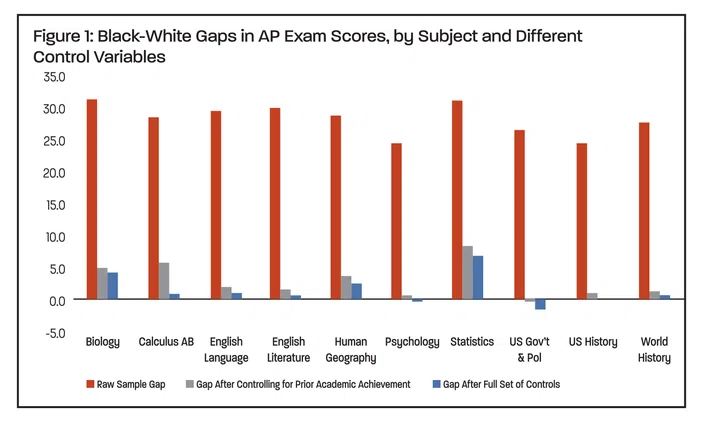A publication of the Association of California School Administrators
Bridging college readiness
Bridging college readiness
Advanced Placement and dual enrollment can set students up for college success
Advanced Placement and dual enrollment can set students up for college success
The Class of 2025 is right around the corner from graduation and taking that next step to college, career and life. As educational leaders, it is imperative that we inform ourselves of patterns and trends in the market to make meaningful decisions to improve student success beyond high school. As a high school assistant principal overseeing Advanced Placement (AP) programs, dual enrollment initiatives and other student support systems, I’ve learned intentional leadership based on research can create opportunities for students to succeed in college and careers.
Equitable access
Research from the College Board article “Understanding Racial/Ethnic Gaps in AP Exam Performance” shares key insights about the importance of prior academic achievement. In Figure 1, you will see the raw gaps in AP exam performance (orange bar) between Black and White students. When you control for the prior academic achievement variable, you can see the gaps (gray bar) are non-existent or diminish depending on the subject area, showing that students who enter the AP Program with similar academic preparation in prior grades, earn similar AP Exam scores (Ewing & Wyatt, 2023).

Understanding the significance of exposing students to rigorous courses, at Heritage High School we’ve shifted our focus to expand access to college-level courses like AP and dual enrollment for all students in our school. Since the 2022-23 school year, our AP program participation has increased by 10 percent while increasing overall scores, and we’ve added an additional section of a dual enrollment course offered through our local Los Medanos Community College. Part of this growth came from our outreach efforts to incoming ninth-grade students from our local middle schools. Every year, we hold an Eighth Grade Parent Night where we have departments from different subject areas present to inform and offer opportunities to our incoming students and families. For example, career technical education (CTE) had an information table operated by the CTE department chair. They discussed the internship opportunities that allow students to gain practical skills. We also have teachers going into classrooms to present about AP courses and embed a Course Preview Day throughout the school year, which also helps with the growth of AP and other elective programs. Course Preview Days are held during an advisory period where all students explore their options by attending the different tables as they speak with teachers and currently enrolled students.
ADVERTISEMENT
Exposure to academic rigor
Dual enrollment courses have bridged the gap between high school and college. Dual enrollment has given students a chance to earn college credit and build confidence in their academic abilities. “Dual enrollment allows high school students to take college courses and earn college credits that can provide a valuable head start toward a college degree. The practice has multiple benefits for students in both systems, improving college preparation and increasing efficiency toward completion of degrees and certificates” (Kurlaender et. al., 2021). These findings highlight the positive outcomes of giving students early exposure to college-level rigor. This early exposure not only gives them college credits that will save students time and money, it also equips them with the confidence of succeeding in college courses they will take in the future. AP courses have a similar impact on students’ future success in college. “Students who take two or more AP Exams are more likely to graduate college on time than students who don’t take an AP course” (Beard et. al., 2019).
Steps to bridging college readiness
1. Identify and expand equitable access to college-level courses. Use your school data to identify gaps in enrollment and achievement in college-level courses. Create a plan to tackle the gaps. It’s OK to start small and focus on one thing at a time.
2. Align academic programs with career and college pathways. Work with local community colleges and industry partners to create pathways that are relevant to your students’ interests. Your focus in this alignment should be related to achieving college credit and college-level course exposure as well as helping students gain practical experience through internships.
3. Develop ongoing support systems for student success. Provide continuous support for students enrolled in college-level courses. This can look like a peer mentoring program, academic workshops and structured study sessions to help increase student achievement. Providing social emotional learning support is essential in addition to academic support.
4. Engage your school community. Parents, students, teachers and other community members should be informed through parent night events. Share additional resources through messaging and events to expand opportunities for all students.
Preparing students for college, career and life is a multifaceted challenge. There is no one way to achieve success in preparing students beyond high school. By expanding access to rigorous programs among all students and providing continuous support for students in all aspects (academics and social emotional), education leaders can empower every student to thrive in a changing world.
References
Beard, J. J., Hsu, J., Ewing, M., and Godfrey, K. E. (2019). Studying the relationships between the number of APs, AP performance, and college outcomes. Educational Measurement: Issues and Practice, 38(4), 42–54. (https://onlinelibrary.wiley.com/doi/abs/10.1111/emip.12295)
Ewing, M., & Wyatt, J. (2023, March). Understanding racial/ethnic gaps in AP® exam performance (Research Brief). College Board.
Kurlaender, M., Reed, S., Grosz, M., Mathias, J., & Hughes, K. (2021). A foot in the door: Growth in participation and equity in dual enrollment in California (Research brief, Vol. 6, No. 7). Wheelhouse: The Center for Community College Leadership and Research, University of California, Davis. https://education.ucdavis.edu
Samir Noor is an assistant principal at Heritage High School in the Liberty Union High School District in Brentwood. Noor is a doctoral candidate in Educational Leadership at University of California, Davis. He was recently selected for the ACSA Delta Charter Secondary Co-Administrator of the Year award.




